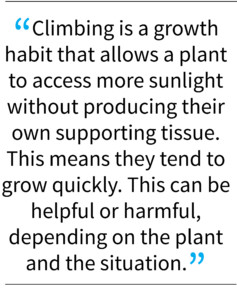Your Garden … with Kate Russell: Be careful of what kind of climbing plants you put in your garden
Selecting the right climbing plant is easier when you understand the different ways they grow
By Kate Russell

Kate Russell
Most Gilroy plants are relatively well-behaved, staying where they are planted and minding their own business. One group of plants, however, refuses to remain earthbound. These plants use everything they touch to move upward. They are the climbers.
Climbing is a growth habit that allows a plant to access more sunlight without producing their own supporting tissue. This means they tend to grow quickly. This can be helpful or harmful, depending on the plant and the situation. Kudzu is a perfect example of how climbing plants can quickly get out of control. Selecting the right climbing plant for your landscape is easier when you understand the different ways they grow.
Some plants twist themselves around supports, while others have tiny hooks that allow them to climb walls, and others have tendrils that wrap around supports and wedge themselves into cracks and crevices. When selecting climbing plants for your landscape, keep in mind just how big these plants can get, where they can go, and how much maintenance they will require before you put them in the ground.
 Cucumbers, melons, pumpkins and grapevines use tendrils to climb. Tendrils are modified stems, leaves, or petioles (leaf stems), depending on the plant. Tendrils respond to touch and wrap themselves around supports. Some stem tendrils can become woody over time, maintaining their support for the life of the plant. Leaf tendril climbers use leaf stems to tie knots around thin supports. Clematis is a common example. These plants tend to be less destructive than other climbing plants.
Cucumbers, melons, pumpkins and grapevines use tendrils to climb. Tendrils are modified stems, leaves, or petioles (leaf stems), depending on the plant. Tendrils respond to touch and wrap themselves around supports. Some stem tendrils can become woody over time, maintaining their support for the life of the plant. Leaf tendril climbers use leaf stems to tie knots around thin supports. Clematis is a common example. These plants tend to be less destructive than other climbing plants.
Self-clinging plants, such as English ivy or Virginia creeper, are able to climb flat surfaces. These climbers attach aerial rootlets, a form of tendril, to walls and fences. These rootlets generally only form on new growth, which becomes detached as the tendril thickens and becomes woody. These self-clinging plants may need some support later on to prevent falling away and they can cause damage to buildings.
Twiners, vines, or lianas are all forms of woody vines. Lianas are perennial, while many of the others tend to be annuals. These plants wrap themselves around supports, thickening over time. Annual twiners include pole beans, morning glories, and hops. These twining vines are also known as bines. Kiwifruit and honeysuckle are both examples of perennial twiners. These plants will readily climb ropes and wires, as well as pergola posts and fencing.
Ramblers, such as blackberries and climbing roses, use thick stems and thorns to create a supportive tangle. Ramblers can be trained along a sturdy trellis, or allowed to create natural mounding growth. Climbing plants grow better if they are given something sturdy to climb. Supports may be other plants, a trellis, a tree, pergola posts, a fence, or your home. They can provide shade, food, and flowers. Some of them can also pull paint, stucco, and roofing tiles off your home. Plan accordingly.
Kate Russell is a UCCE Master Gardener in Santa Clara County. For more information, visit mgsantaclara.ucanr.edu or call (408) 282-3105 between 9:30 a.m. and 12:30 p.m., Monday through Friday.
- Your Garden . . . with Kate Russell: Plant your garden according to watering needs, known as hydrozoning - August 12, 2021
- Your Garden . . . with Kate Russell: Trade in your lawn for a meadow and reduce maintenance chores - July 15, 2021
- Your Garden . . . with Kate Russell: The right soil chemistry balance will go a long way for healthy plants - June 17, 2021
